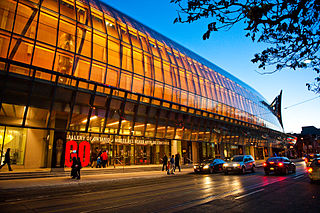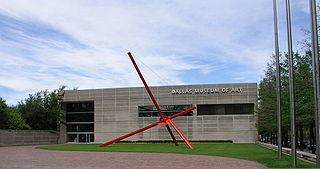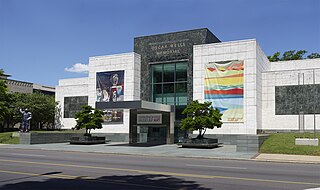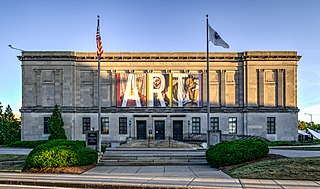
Leo Michelson was a Latvian-American artist considered part of the École de Paris, although his works span many periods and styles.

The Art Gallery of Ontario is an art museum in Toronto, Ontario, Canada. The museum is located in the Grange Park neighbourhood of downtown Toronto, on Dundas Street West between McCaul and Beverley streets. The museum's building complex takes up 45,000 square metres (480,000 sq ft) of physical space, making it one of the largest art museums in North America and the second-largest art museum in Toronto after the Royal Ontario Museum. In addition to exhibition spaces, the museum also houses an artist-in-residence office and studio, dining facilities, event spaces, gift shop, library and archives, theatre and lecture hall, research centre, and a workshop.

The Dallas Museum of Art (DMA) is an art museum located in the Arts District of downtown Dallas, Texas, along Woodall Rodgers Freeway between St. Paul and Harwood. In the 70's, the museum moved from its previous location in Fair Park to the Arts District. The new building was designed by Edward Larrabee Barnes and John MY Lee Associates, the 2007 winner of the American Institute of Architects Gold Medal. The construction of the building spanned in stages over a decade.

The Baltimore Museum of Art (BMA) in Baltimore, Maryland, United States, is an art museum that was founded in 1914. The BMA's internationally renowned collection of 95,000 objects encompasses more than 1,000 works by Henri Matisse anchored by the Cone Collection of modern art, as well as one of the nation's finest holdings of prints, drawings, and photographs. The galleries currently showcase collections of art from Africa; works by established and emerging contemporary artists; European and American paintings, sculpture, and decorative arts; ancient Antioch mosaics; art from Asia, and textiles from around the world.

The Yale Center for British Art at Yale University in downtown New Haven, Connecticut, houses the largest and most comprehensive collection of British art outside the United Kingdom. The collection of paintings, sculpture, drawings, prints, rare books, and manuscripts reflects the development of British art and culture from the Elizabethan period onward.

The Amon Carter Museum of American Art (ACMAA) is located in Fort Worth, Texas, in the city's cultural district. The museum's permanent collection features paintings, photography, sculpture, and works on paper by leading artists working in the United States and its North American territories in the nineteenth and twentieth centuries. The greatest concentration of works falls into the period from the 1820s through the 1940s. Photographs, prints, and other works on paper produced up to the present day are also an area of strength in the museum's holdings.

Founded in 1951, the Birmingham Museum of Art in Birmingham, Alabama, today has one of the finest collections in the Southeastern United States, with more than 24,000 paintings, sculptures, prints, drawings, and decorative arts representing a numerous diverse cultures, including Asian, European, American, African, Pre-Columbian, and Native American. Among other highlights, the Museum’s collection of Asian art is considered the finest and most comprehensive in the Southeast, and its Vietnamese ceramics one of the finest in the U.S. The Museum also is home to a remarkable Kress Collection of Renaissance and Baroque paintings, sculpture, and decorative arts from the late 13th century to c.1750, and the 18th-century European decorative arts include superior examples of English ceramics and French furniture.

The Worcester Art Museum, also known by its acronym WAM, houses over 38,000 works of art dating from antiquity to the present day and representing cultures from all over the world. WAM opened in 1898 in Worcester, Massachusetts, and ranks among the more important art museums of its kind in the nation. Its holdings include some of the finest Roman mosaics in the United States, outstanding European and American art, and a major collection of Japanese prints. Since acquiring the John Woodman Higgins Armory Collection in 2013, WAM is also home to the second largest collection of arms and armor in the Americas. In many areas, it was at the forefront in the US, notably as it collected architecture, acquired paintings by Monet (1910) and Gauguin (1921), presented photography as an art form (1904) The Worcester Art Museum also has a conservation lab and year-round studio art program for adults and youth.

The Modern Art Museum of Fort Worth is an art museum of post-World War II art in Fort Worth, Texas with a collection of international modern and contemporary art. Founded in 1892, The Modern is located in the city's cultural district in a building designed by architect Tadao Ando which opened to the public in 2002. The museum is accredited by the American Alliance of Museums and holds a permanent collection with more than 3,000 works of art.

The Jack S. Blanton Museum of Art at the University of Texas at Austin is one of the largest university art museums in the U.S. with 189,340 square feet devoted to temporary exhibitions, permanent collection galleries, storage, administrative offices, classrooms, a print study room, an auditorium, shop, and cafe. The Blanton's permanent collection consists of almost 18,000 works, with significant holdings of modern and contemporary art, Latin American art, Old Master paintings, and prints and drawings from Europe, the United States, and Latin America.

The Museum of Fine Arts, Houston (MFAH), located in the Houston Museum District, Houston, is one of the largest museums in the United States. The permanent collection of the museum spans more than 6,000 years of history with approximately 70,000 works from six continents.
The Albany Museum of Art is located in Albany, Georgia, United States. The museum is a non-profit organization governed by a 28-member elected board of directors.

The Grace Museum is located in Abilene, Texas, United States. The museum is accredited by the American Alliance of Museums (AAM). The Grace Museum houses five art galleries featuring rotating art exhibitions and artwork from the permanent collection; a history gallery with permanent and rotating exhibits featuring Abilene, Taylor County, and West Texas artifacts; an art library; an education center and an interactive gallery for children and families. The Abilene Fine Arts Museum was founded in 1937 by the Art League of the Abilene Woman's Club. The art museum was housed in various downtown locations and Rose Park before the current facility was renovated in 1992. Since 1992, the museum has existed as The Museums of Abilene, Grace Cultural Center and the name was officially changed to The Grace Museum in 1998.

Museum of Art, Rhode Island School of Design is an art museum in Providence affiliated with the Rhode Island School of Design, in the U.S. state of Rhode Island. The museum was founded in 1877 and is the 20th largest art museum in the United States.
The Housatonic Museum of Art is a museum at Housatonic Community College in Bridgeport, Connecticut. The museum's collection is displayed throughout the college campus and in the Burt Chernow Galleries, which also hosts visiting exhibitions.

The Fairfield University Art Museum, formerly the Bellarmine Museum of Art, is an art museum located on the renovated lower level of Bellarmine Hall on the campus of Fairfield University in Fairfield, Connecticut. The museum features Classical, Medieval, Renaissance, Baroque, Celtic and Asian art and artifacts in three distinct galleries totaling 2,700 square feet (250 m2) of space. The museum hosts 2-3 special exhibitions each year in the Bellarmine Hall Galleries. The museum also includes the Walsh Gallery, in the Regina A. Quick Center for the Performing Arts, with 1800 square feet of exhibition space. The Walsh Gallery hosts 2-3 special exhibitions annually. CollegeRank.net ranks it the 37th Most Amazing College Museum in the United States noting that "with an incredibly rich and broad collection of paintings, sculpture, and plaster casts, the Bellarmine Museum of Art is a must-see for art enthusiasts."

The University of Arizona Museum of Art (UAMA) is an art museum in Tucson, Arizona, operated by the University of Arizona. The museum's permanent collection includes more than 6,000 works of art, including paintings, sculptures, prints and drawings with an emphasis on European and American fine art from the Renaissance to the present.

The University of New Mexico Art Museum is an art museum at the University of New Mexico in Albuquerque. The museum's permanent collection includes nearly 30,000 objects, making it the largest collection of fine art in New Mexico.

The Palmer Museum of Art is the art museum of Pennsylvania State University, located on the University Park campus in State College, Pennsylvania.

The Old Jail Art Center (OJAC) is an art and regional history museum in Albany, Texas. It is housed in a former jail that was completed in 1878. After being replaced by a new jail in 1929, the old jail building was saved from demolition by local author and playwright Robert E. Nail Jr. in 1940. In 1980, the OJAC was established in the building by his nephew, local author and former television producer Reilly Nail, and Reilly's cousin, artist Bill Bomar.